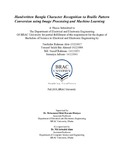| dc.contributor.advisor | Bhuiyan, Mohammed Belal Hossain | |
| dc.contributor.advisor | Alam, Md. Ashraful | |
| dc.contributor.author | Abir, Tawhidur Rahman | |
| dc.contributor.author | Ahmed, Touseef Saleh Bin | |
| dc.contributor.author | Rahman, Md. Tausif | |
| dc.contributor.author | Jafreen, Sumaiya | |
| dc.date.accessioned | 2019-02-27T05:50:04Z | |
| dc.date.available | 2019-02-27T05:50:04Z | |
| dc.date.copyright | 2018 | |
| dc.date.issued | 2018-12 | |
| dc.identifier.other | ID 13221017 | |
| dc.identifier.other | ID 14221004 | |
| dc.identifier.other | ID 14121031 | |
| dc.identifier.other | ID 14121041 | |
| dc.identifier.uri | http://hdl.handle.net/10361/11473 | |
| dc.description | This thesis is submitted in partial fulfilment of the requirements for the degree of Bachelor of Science in Electrical and Electronic Engineering, 2018. | en_US |
| dc.description | Catalogued from PDF version of thesis. | |
| dc.description | Includes bibliographical references( pages 54-57). | |
| dc.description.abstract | There has been significant development in the recent Education System with the rapid development of
technology however there are very few facilities that can help those people with disabilities such people
without sight. Braille has been one such method however it has not yet been digitized or has not been
incorporated in the education system. On the other hand, many papers and works have been conducted on
English Character Recognition with satisfactory outcomes with considerably good accuracy however such
cannot be said about Bengali Characters. Some works have been done with considerable accuracy
however its frequency is still low. This paper introduces the development of a prototype system which
takes an image of a handwritten Bangla Character and applies the concepts of Image Processing using
OpenCV and Machine Learning to capture and process an image then recognize the character and finally
with the help of a device present the recognized character in a Braille pattern. Furthermore, this paper will
also look into the different machine learning modules and assess the reliability and accuracy. For the
machine learning part Deep Neural Network was applied on the image and then VGG-16 , Resnet-50 and
DenseNet-121 which are modules of Convoluted Neural Networks where used. Then the outcome is
passed into a device which will engrave the corresponding character into its respective Braille Pattern.
The device will consist of Atmega2560 chipset (Arduino Mega) , Servo Motor and LCD which will
process the data and finally present it in Braille pattern using servo motor and will show the
corresponding character on the LCD monitor. | en_US |
| dc.description.statementofresponsibility | Tawhidur Rahman Abir | |
| dc.description.statementofresponsibility | Touseef Saleh Bin Ahmed | |
| dc.description.statementofresponsibility | Md. Tausif Rahman | |
| dc.description.statementofresponsibility | Sumaiya Jafreen | |
| dc.format.extent | 57 pages | |
| dc.language.iso | en | en_US |
| dc.publisher | BRAC University | en_US |
| dc.rights | BRAC University theses are protected by copyright. They may be viewed from this source for any purpose, but reproduction or distribution in any format is prohibited without written permission. | |
| dc.subject | Character recognition | en_US |
| dc.subject | Braille pattern | en_US |
| dc.subject | Image processing | en_US |
| dc.subject | Machine learning | en_US |
| dc.subject.lcsh | Artificial intelligence. | |
| dc.subject.lcsh | Image processing | |
| dc.subject.lcsh | Data mining | |
| dc.title | Handwritten Bangla character recognition to braille pattern conversion using image processing and machine learning | en_US |
| dc.type | Thesis | en_US |
| dc.contributor.department | Department of Electrical and Electronic Engineering, BRAC University | |
| dc.description.degree | B. Electrical and Electronic Engineering | |

